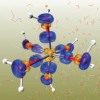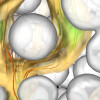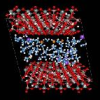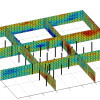Environmental Science
NERSC users advance fundamental science to understand, predict and mitigate the impact of environmental contamination. One of the most important problems involves hazardous materials that have leached into the subsurface and are at risk of being more widely dispersed by groundwater flow. Rigorous models that accurately simulate reactive contaminant movement and incorporate coupled physical, chemical and biological processes are required for to create predictive capabilities applicable to field-scale subsurface contamination problems. The goal is scientifically-driven decision making for environmental remediation and long-term stewardship.
NERSC has played and will continue to play a vital role for this key Office of Science mission driver. The key challenge is the widely varying scales involved. Important biogeochemical processes (e.g., microbial respiration) are best understood at very small scales, typically ranging from molecular to cellular level, with time scales of minutes to days. However, predicting phenomena in aquifers requires very large simulations typically ranging from meters to kilometers and time scales of months to years or even centuries. This problem is aggravated by the variability of natural subsurface properties that exist across the broad spectrum of spatial and temporal scales.
Representative examples of this research appear below.
Chemistry of Metal Contaminants in Water
Molecular modeling is used here to understand hydration structure of metal ions related to contaminant activity in subsurface environments. Dissolved metals play a role in mineral extraction, toxic material transport and biochemical activation but their structure is difficult to obtain experimentally.
Read More »
Multiscale Subsurface Biogeochemical Modeling
In this SciDAC Science Application researchers are developing an integrated multiscale modeling framework to directly link subsurface flow, transport, and reaction process models across huge length scales spanning continuum, pore, and sub-pore regions. Read More »
Connecting the Molecular and the Continuum Scales
How do continuum-scale transport properties arise from molecular- and pore-scale features in porous media? Research is addressing this question using molecular dynamics to determine molecular-scale diffusion coefficients in Na-smectite interlayers. Read More »
New Approaches for Understanding the Hanford 300 Area
Improved simulations of subsurface flow and transport processes will help improve
our ability to assess various remediation strategies as part of the Hanford Integrated Field Research Challenge. Read More »
New Methods for Characterizing Porous Materials
Porous materials such as zeolites are of growing importance as materials for energy-related applications such as carbon capture or gas storage. Although more than 2.5 million zeolite structures probably exist, only about 190 have been synthesized. This work seeks to predict which structures will be optimal for CO<sub>2</sub> separation. Read More »












